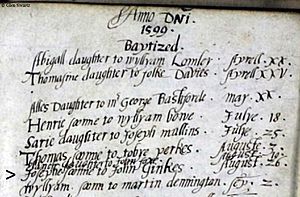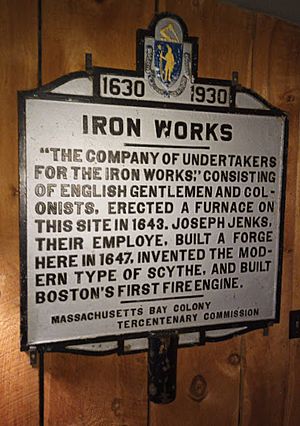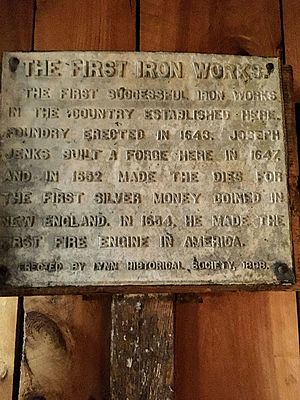Joseph Jenckes Sr. facts for kids
Quick facts for kids
Joseph Jenckes Sr.
|
|
|---|---|
| Baptized | August 26, 1599 St. Ann Blackfriars, London, England |
| Died | March 16, 1683 (aged 83) |
| Occupation | Bladesmith, blacksmith, mechanic, inventor |
| Known for | First machine patent in America |
| Spouse(s) |
|
| Parents |
|
Joseph Jenckes Sr. (born in 1599 and died in 1683) was a skilled craftsman and inventor. He worked with metal as a bladesmith and blacksmith. He helped start the Saugus Iron Works in what is now Massachusetts. He also received the very first machine patent in North America.
Joseph grew up in London, England. His family made tools and knives. He worked at a sword factory. After some sad family events, he moved to New England. He left his son, Joseph Jr., with family in England.
Around 1645, Joseph Jenckes Sr. was working at the Saugus Iron Works. This was near Lynn. He is known for making the first metal casting in North America. He also invented a new type of scythe (a tool for cutting grass). He even made tools for the first coins made in North America.
His son, Joseph Jenckes Jr., later joined him at Saugus. Joseph Jr. went on to found the town of Pawtucket. Other important people in his family include a founder of Brown University. Another was a governor of colonial Rhode Island.
Contents
Joseph Jenckes's Early Life and Family
Joseph Jenckes was baptized on August 26, 1599. This happened at St. Ann Blackfriars church in London. His parents were John Jenckes Sr. and Sarah Fulwater. They lived in the same area of London.
Joseph came from a family of "cutlers." These were people who made knives and other sharp tools. His father and half-brothers were also cutlers. His grandfather, Henry Fulwater, was a cutler too.
London had special groups called "livery companies." These groups controlled different trades. They also offered training for young people. Being a member gave you social standing and voting rights. Sometimes, people joined a company even if they didn't do that specific trade. This is why some Jenckes family members were in a bakers' group!
In 1627, Joseph Jenckes got married. He married in Horton, Buckinghamshire, which is west of London.
Working at a Sword Factory
From about 1629 to 1641, Joseph Jenckes worked at a sword factory. This factory was run by Benjamin Stone in Hounslow, Middlesex. It was about 14 miles west of London.
In 1629, Benjamin Stone turned a grain mill into a sword factory. He did this to make swords for the Thirty Years' War. This war was happening in Europe from 1618 to 1648. Stone hired English and German sword makers. The swords were mostly sent to the Tower of London's armory. The factory made the most swords between 1634 and 1637.
Today, a museum in Welshpool, Wales, has a sword made by Joseph Jenckes. The sword blade has "JENCKES JOSEPH" on one side. On the other side, it says "ME FECIT HOVNSLO." This means "Made in Hounslow."
Moving to New England
While living in Hounslow, Joseph Jenckes faced some challenges. His wife passed away in 1635. One of his two children died in 1638.
In 1639, he asked for permission to build a new type of blade mill. It's not known if he built it. Around 1641, Jenckes left his only child, Joseph, with family in England. He then moved to New England.
By 1642, Jenckes was mentioned in records in New Hampshire. In 1643, he was in a land record near Kittery, Maine. Two years later, he was working at the Saugus Iron Works. This was near Lynn in Massachusetts Bay.
Working at the Saugus Iron Works
Building the Ironworks
By 1645, Joseph Jenckes was connected to the Hammersmith ironworks. This place was later called the Saugus Iron Works. It used the most advanced technology of its time. It was the first successful iron-making factory in North America.
The idea to build an ironworks on the Saugus River started much earlier. In the late 1620s, a special kind of iron ore was found. It was called bog iron ore. It was found in the Saugus River marshes near Lynn. In 1641, John Winthrop the Younger sent samples of this ore to England. Soon, a group of investors decided to fund the project.
In 1647, Joseph Jenckes received permission to build his own shop. He built his foundry and forge near the Saugus Iron Works. In the mid-1650s, the ironworks company went bankrupt. Joseph Jenckes bought some of the buildings and machines. These included his own shop and other mills. The ironworks stopped making iron in 1678. Joseph Jenckes died in 1683.
Discoveries at the Jenckes Site
From 1948 to 1953, an archaeologist named Roland W. Robbins dug up different areas at the Saugus Iron Works. In 1952, he dug at what he called the "Jenks Site." This is where Jenckes built his foundry and forge.
Robbins found many old objects there. These included parts of tools like axes, chisels, and knives. He also found parts of water wheels and a sawmill blade. Other items were a scythe, hoes, and spades. He even found what looked like Jenckes's forge (a special furnace). He also found signs of a wire-making operation.
Joseph Jenckes's Key Achievements
First Machine Patent in North America
In 1646, Joseph Jenckes received the first machine patent in North America. A patent is like a special permission. It means only you can make or sell your invention for a certain time. His patent was for 14 years.
His invention was a new water-powered machine. It could make scythes, sawmill blades, and other sharp tools. He asked the government for the same rights given in England. He explained that he had spent years studying and working on his invention. He wanted to protect his ideas from others copying them. The patent was approved by the governor, John Winthrop.
First Metal Casting in North America
Joseph Jenckes made the very first iron casting in North America. This was a small pot with three legs and a handle. It is now called the Saugus Pot. You can see it at the Saugus Public Library. Tests have shown that the metal of the pot matches metal found at Jenckes's forge site.
Improved Scythe Patent
In 1655, Jenckes received another patent. This one was for an improved scythe. It was designed to cut grass faster. Old European scythes had a straight handle and a short, thick blade.
Jenckes's new scythe was much better. It had a handle that curved twice. The blade was longer, thinner, and lighter. It also had a special rib on the back to make it stronger. This new design became known as the "American scythe." It is still used today and looks very similar.
Tools for the First North American Coins
It is believed that Joseph Jenckes made tools for the first coins in North America. In 1652, John Hull and Robert Sanderson were chosen to make coins for Massachusetts Bay Colony.
While there's no direct proof, many think Jenckes made the tools they needed. These tools included steel punches and blank dies for the coins. In the 1650s, the Saugus Iron Works was the only place hot enough to make these special steel tools.
Jenckes was interested in making coins himself. In 1672, he asked the government for permission to make coins. However, his request was not approved.
First Fire Engine in North America
In 1653, Boston had a big fire. The next year, Boston leaders decided to buy fire engines from Joseph Jenckes. They wanted "Ingins to Carry water in Case of fire." It's not fully confirmed if Jenckes made the engine. However, records from 1702 mention an old engine that might have been his.
The Legend of Thomas Veale
There's a popular story about Joseph Jenckes's forge. In 1658, a pirate named Captain Thomas Veale and three others supposedly sailed up the Saugus River. They visited Jenckes's forge at night. They left a note asking for shackles (metal restraints).
The story says Jenckes made the shackles. But they were used on three of the pirates! Veale escaped and buried his treasure in a cave. This cave is now called Dungeon Rock. The legend says he died there during an earthquake.
Joseph Jenckes's Family Life
Joseph Jenckes married Joan Hearne on November 5, 1627. She was born around 1607 and died in 1635. They had two children: Elizabeth (born around 1630) and Joseph Jenckes Jr. (born 1628). His daughter Elizabeth died in England in 1638. His son Joseph Jr. stayed in England when his father moved. But Joseph Jr. later joined his father at the Saugus Iron Works around 1647.
Joseph Jenckes married a second time around 1650 in New England. His second wife was named Elizabeth, but her last name is unknown. She died in 1679. They had five children together: Sarah (born 1652), Samuel (born 1654), Deborah (born 1658), John (born 1660), and Daniel (born 1663).
His son Joseph Jenckes Jr. helped found Pawtucket, Rhode Island. His grandson, Joseph Jenckes 3rd, became the 19th governor of Rhode Island. A later family member was Nicholas Brown Jr., who helped found Brown University.
Joseph Jenckes's Legacy
The Saugus Iron Works is seen as the starting point for the iron and steel industry in North America. You can see some of Joseph Jenckes's inventions and tools at the museum there. A copy of his patent is also on display. There are also historical markers that talk about his important work.
|







